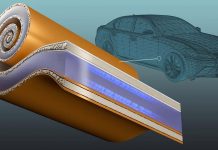
Researchers from TU Delft, along with an international team, have made an exciting breakthrough in battery technology that could greatly extend the life of lithium-ion batteries, a key component in renewable energy storage.
Their findings were recently published in the prestigious journal, Nature.
Lithium-ion (Li-ion) batteries are crucial for storing energy, especially as the world shifts towards more renewable energy sources like solar and wind.
These batteries are used in everything from smartphones to electric cars because of their ability to hold a significant amount of energy.
One of the main challenges with these batteries is their lifespan, which is determined by how many times they can be charged and discharged before they start losing efficiency.
This is often referred to as the battery’s ‘cycle life’.
Typically, the materials inside the battery degrade over time, especially during charging, which limits the battery’s overall lifespan.
The TU Delft team discovered that introducing a bit of disorder into the atomic structure of the battery’s cathode material can actually make it more stable and increase the battery’s cycle life.
Traditionally, the cathode materials in Li-ion batteries are very orderly, but this orderliness can become unstable when the battery charges.
Led by Qidi Wang, the researchers experimented with adding what they call “chemical short-range disorder” to the cathode material. This means they slightly disrupted the neat arrangement of atoms in the material.
To their surprise, this disorder didn’t weaken the battery; instead, it made the cathode more stable during the charging process.
This increased stability nearly doubled the battery’s efficiency after 200 charge-discharge cycles. Moreover, this new method also helps the battery charge faster.
The team demonstrated these improvements using common commercial battery materials like lithium cobalt oxide and lithium nickel manganese cobalt oxide.
These advancements mean not only longer-lasting batteries but also potential reductions in manufacturing costs and environmental impact, since the batteries would need to be replaced less frequently.
The researchers are now looking into using less scarce materials to make these cathodes, which could further reduce the cost and environmental footprint.
This discovery opens the door to the next generation of Li-ion batteries, promising a future where batteries last longer, charge faster, and are more environmentally friendly.
Source: KSR.



